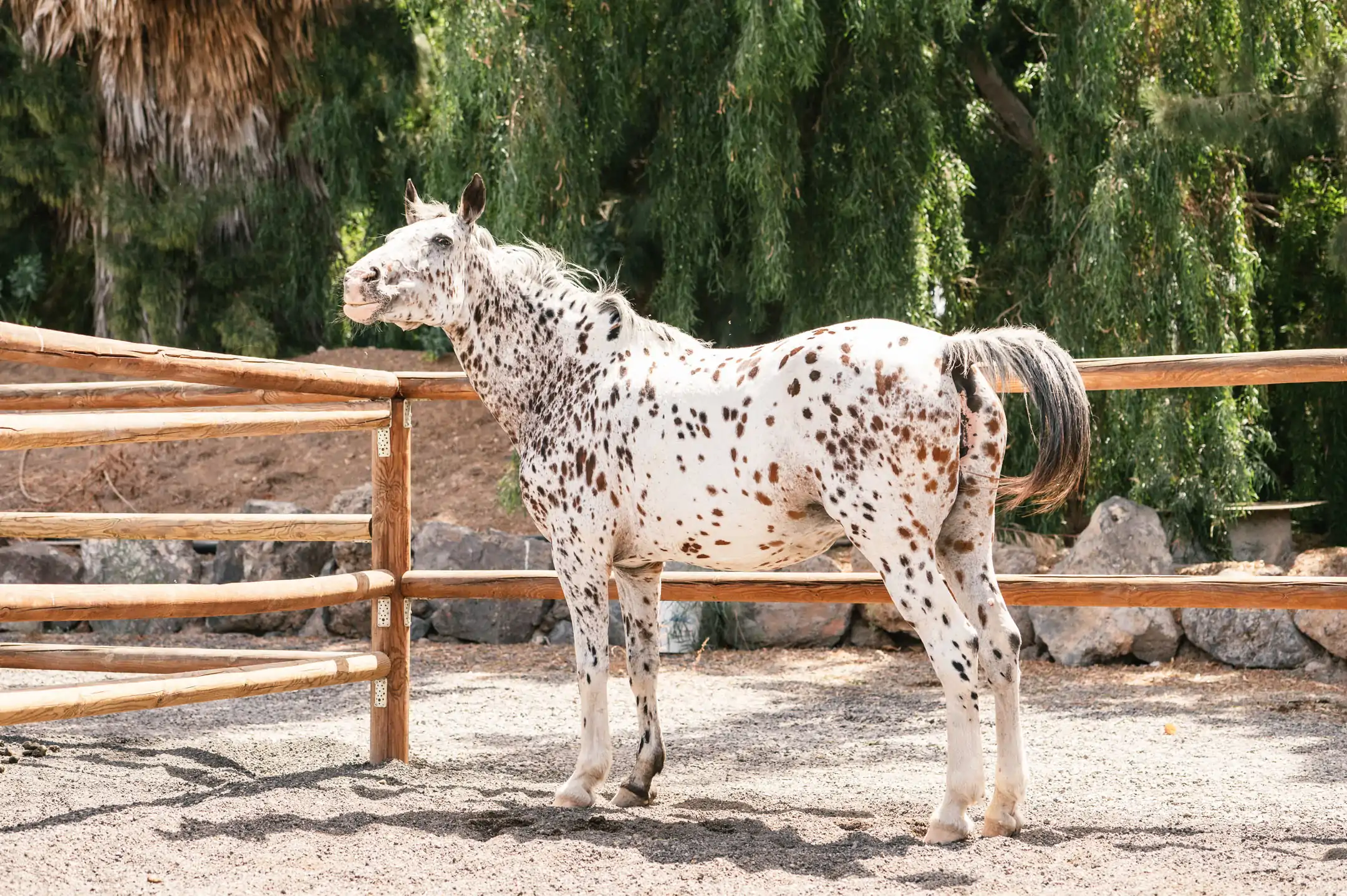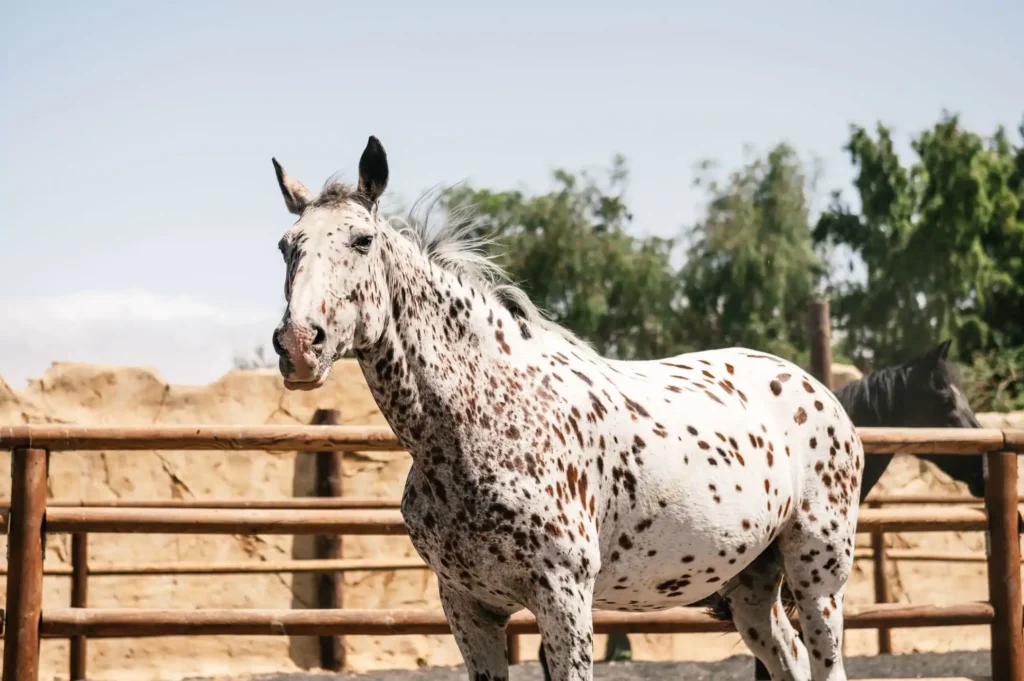The Appaloosa is a horse breed. The colour pattern that distinguishes the Appaloosa from other horses is of genetic origin and relates them directly to primitive horses. The earliest evidence of horses with a spotted coat pattern is from the cave paintings dating from more than 20.000 years ago. In ancient Persia, horses with this coat where highly appreciated and considered “the sacred horses of Nissea”. In China, the presence of horses with spotted coat was discovered around 100 BC. With them, the Chinese could face the horses from central Asia which dominated in the wars and conflicts of that time. From the 7th century on, there is record of “spotted” horses in Chinese pieces of art, which demonstrates their high estimation for this breed. In Europe, the “spotted” horses can be found throughout history, although this coat was mainly concentrated in Andalusian and Lipizzaner horses. The Appaloosa appears in early cave paintings from more than 20 thousand years ago, like the ones at Peche-Merle in France.
Main characteristics
In America, horses with spotted coat were common among the Andalusian horses, which had been brought to the “New World” by the Spanish conquerors in the 16th century. This way the Appaloosa horses came to America, where they expanded over the northern states until they were discovered by the Indian tribe of the Nez Perce people, who lived in the northwest of the US, what today is eastern Washington and Oregon.
The Nez Perce considered that these horses where exactly what they were looking for: an ideal horse for hunting and war, due to its coat colour, tempered character, versatility and robust structure. During more than 200 years, the Nez Perce developed a strict selection of horses, using only the very best for breeding. This way they settled the basis for the genetic elements that characterize nowadays the Appaloosa horse. The name “Appaloosa” goes back to the Palouse River, which crossed the settling grounds of the Nez Perce.
Ceramic art works from the beginning of the Christian era show clearly the predilection of the Chinese for the Appaloosa breed.
There is six different types of coats:
• Blanket – white over the hip that may extend from the tail to the base of the neck. The spots inside the blanket (if present) are the same colour as the horse’s base coat.
• Leopard – A horse whose Appaloosa white patterning is exhibited to an extreme with base coloured spots of various sizes covering most of its body.
• Few Spot Leopard – This is a horse whose base colour is nearly obscured by its Appaloosa white patterning covering up to 90% of its body. Horse may exhibit patches of colour on the heads, knees, elbows, flanks (called “varnish marks”). Some may have as few as only one or two spots.
• Snowflake – A horse with white spots, flecks, on a dark body. Typically the white spots increase in number and size as the horse ages.
• Varnish roan – dark points (legs and head) and some spots or roaning over a light body. May occur in conjunction with another spotting style and change with age. Often starts out as a solid coloured horse that gets more white as it ages, but is not a grey.
• Frost – similar to varnish but the white hairs are limited to the back, loins, and neck. May occur in conjunction with another spotting style and change with age. Often starts out as a solid coloured horse that gets more white as it ages. * Generally, male horses may present more vivid colours and spots than female horses. * Their neck is of regular length and well formed. * The croup is round and muscular. * Their legs are slender and angular, but of high resistance. * Their tail and mane is not necessarily exuberant.
The Appaloosa horses have three other distinctive characteristics:
- Mottled skin: This characteristic is unique to the Appaloosa horse. Therefore, mottled skin is a basic and decisive indicator of an Appaloosa. Mottled skin is different from commonly found pink skin, in that it normally contains dark areas of pigmented skin within its area. The result is a speckled pattern of pigmented and non-pigmented skin. This pattern can be found in different parts of the body. Apart from the muzzle and the skin surrounding the eyes, it can be found also in the genital area. Some horse breeds show patches of pink skin without pigmentation, which should not be confused with the mottled skin of the Appaloosa.
* White Sclera: The sclera is the area of the eye which encircles the iris (the coloured portion). The white of the human eye is an example. All horses have sclera but the Appaloosa’s is white and usually more readily visible than other breeds. All horses can show white around the eye if it is rolled back, up or down or if the eyelid is lifted. Readily visible white sclera is a distinctive Appaloosa characteristic provided it is not in combination with a large white face marking.
* Striped hooves: Many Appaloosas will have bold and clearly defined vertically light or dark striped hooves. Vertical stripes may result from an injury in the coronet or a white marking on the leg of the animal. Striped hooves do not necessarily identify an Appaloosa horse. If you have doubts concerning your Appaloosa, please confirm that the other distinctive criteria apply to your horse.




